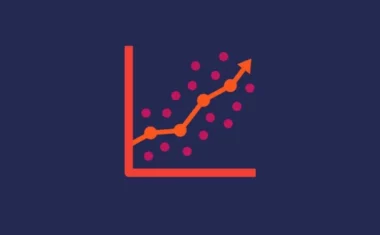Free Data Analytics Course
Jumpstart your journey with 25 essential learning units in data analytics. No cost, just knowledge.
Working as a freelance data analyst offers some of the best of both worlds—you get to work in an exciting and growing industry, while also getting the flexibility that comes with any freelance role. As a freelancer, you can set your own hours, work from wherever you want, and work as much (or as little) as you’d like.
But becoming a freelance data analyst is no walk in the park, and while the upsides are appealing, there are some downsides too. Breaking into the field, getting clients, and sustaining yourself during the initial months—are just some of the challenges at hand.
Explore the world of freelancing with us. We’ll discuss the pros and cons of this career route, and help you get started on how to become a freelance data analyst with 8 actionable steps.
What Is a Freelance Data Analyst?
Data analysts collect, clean, and study data to solve business problems for a company. A freelance data analyst does this as an independent business owner for multiple clients. Freelance data analysts do not work as an employee for one organization. Instead, they work as an independent contractor for one or more clients at an hourly or project-based rate.
Why Go the Freelance Route?
One of the biggest advantages of becoming a freelance data analyst is that you can work as much or as little as you’d like. And once you can command a stable rate, this means that you can make as much or as little money as you like. With freelancing, you set your own hours and aren’t beholden to a specific location or timezone. It’s all up to you!
As is the case with any freelancer, you’re essentially running a one-person business, so it can be an exciting career path if you’re interested in learning how to market your services, sustain your freelance business, and handle client expectations.
How To Become a Freelance Data Analyst: An 8-Step Guide
Here are eight steps to establish yourself as a freelance data analyst successfully:
-
Make a Concrete Plan
-
Determine Your: Services, Pricing
-
Develop Your Online Presence
-
Identify Leads and Land Your First Client
-
Establish Your Freelance Business
-
Hone and Build Upon Your Skillset
-
Get Involved in the Data Community (and Interact With Other Freelancers)
-
Grow Your Business
Make a Concrete Plan
Let’s assume you have 2-3 years of experience as a data analyst at a company (if not, you can still become a data analyst without experience). If you now want to branch out on your own, here’s what you can do to formulate a plan:
Research
Read up on the current state of the market for freelance data analysts. Understand how people have built their businesses, what tools they have used, and what kind of services they offer. Dive into both positive and negative experiences that people have written about. Even before you begin your journey, you will get a vague idea of what to do and what not to do.
Create a Roadmap for Your Freelancing Journey
Sketch a rough blueprint of what you will do in the next month, three months, or six months to get started. This could include contacting your employer and asking them if they have independent projects you can eventually work on. Address any knowledge gaps you may have.
Set Aside an Emergency Fund
In your initial months as a freelancer, you most likely won’t earn what you were making before at your full-time job. Assume that business will be slow for the first 4-6 months. A thumb rule that professionals follow is to save six months of expenses. You’ll be able to tide over the initial roadblocks and any famine periods with this emergency fund.
Determine Your:
Once you’ve done your research, determine the following for yourself:
Services
Go through profiles of other data analysts on freelancing websites and marketplaces. See what kind of services they offer and what matches your expertise. Your offering should be aligned with your data analytics portfolio.
Pricing
If you’re charging an hourly rate, first research the market rate for your services. See what other freelancers charge, and then consider your own expenses. Another way is to quote on a project basis. Calculate the project rate by estimating how long it will take you.
Seasoned freelancers consider retainer-based packages as the ideal pricing option. This is because you will know roughly how much you will make every month and avoid uncertainty.
Remember to revise your prices at least once a year based on market rates and your professional experience as a freelancer. Keep in mind that initially, you cannot charge a high rate. When clients see you as an authority in the field based on your personal brand, quote higher rates. Eventually, you can surpass what you earned as a full-time employee based on your work quality, testimonials, and marketing efforts.
Develop Your Online Presence
Your personal branding efforts can be a game-changer for lead generation. Here’s how to go about it.
Build a Strong Portfolio
Your portfolio can be a website, a blog on Medium, or a GitHub profile with 3-4 projects. Talking through the process and steps you used tells potential clients you possess the knowledge to see a project through. Don’t forget to add the business impact of what you created.
Create a Well-Optimized LinkedIn Profile
Position yourself as an authority in data analysis on LinkedIn to get clients. Look at the LinkedIn profiles of other freelance data analysts doing well to identify keywords you should include in your “About” section. Engage with other freelancers and experts in the field. Regularly post about your experiences, and share your knowledge to build an audience.
Identify Leads and Land Your First Client
Your first client can be all you need to get a pipeline of referrals. Create an Excel sheet listing businesses you want to work with and how to contact them. Pitch daily in a disciplined manner. At this juncture, it’s about getting to as many inboxes as possible. Keep a lookout on LinkedIn for opportunities and send connection requests to businesses you can assist.
Establish Your Freelance Business
Once you get the ball rolling, you are officially in business. Now it’s time to get some other puzzle pieces in place, such as:
Register Your Business Appropriately
For tax benefits, you need to register your freelance business, usually as an LLC. Choose a name for your business and use the suitable business law legislation to constitute your business legally. You will also have to open a bank account in the name of your business.
Build a Basic Tech Stack for Invoicing, Client Management, Communication, etc.
It’s essential to have software that helps you build and manage contracts, invoices, and communications with clients.
Get a Contract Template and Other Documents in Place
When you onboard clients, it’s advisable to sign a contract that outlines deliverables, timelines, fees, contingency clauses, and other miscellaneous considerations (for example, a kill fee if you or the client back out, a notice period for ending the contract, confidentiality agreements, etc.). Have a contract template ready and a sample of a Non-Disclosure Agreement (NDA).
Get Insurance
Remember that you are not an employee and don’t get the same safeguards and perks. This includes insurance for both yourself and your freelance business. Consider buying:
- Freelance public liability insurance
- Private health insurance
- Comprehensive life insurance
Hone and Build Upon Your Skillset
Develop these essential skills to become a successful data analyst and a thriving freelancer.
Technical Skills
Learning data analytics tools like Excel is essential. You also need to know how to use data visualization to communicate your findings and engage in effective data storytelling. Knowing programming languages like Python (for pure coding) and R (for statistical programming) is also vital. Along with these, SQL is necessary too. As a data analyst, you should also know core mathematics (calculus and linear algebra) and statistical analysis. If you’re looking for a structured way to learn data analytics, check out Springboard’s Data Analytics Bootcamp.
Soft Skills
Soft skills will help you scale your business. This goes beyond the usual, like time management, organizational skills, and strong problem-solving skills. Communication skills are critical here. It is necessary to learn how to conduct pitch meetings and client calls. The goal is to have multiple clients, so project management will also become necessary.
Get Involved in the Data Community (and Interact With Other Freelancers)
Among other data platforms, Slack, Reddit, and LinkedIn have thriving data communities. Through these platforms, you’ll get the opportunity to get (and share) valuable tips from other freelancers who are probably going through similar hiccups as you. Participate in online conferences, discussions, and workshops to improve your soft skills, keep up-to-date on technical skills, and stay in tune with market rates.
Grow Your Business
Working on your business involves a lot of “unpaid” work, like marketing and lead generation. Automate those portions to take time out for client work. Eventually, try to niche down and specialize within your field of expertise. Data analysis percolates every industry, and you can’t cater to everyone. Narrow your target audience and offer specialized skills and domain expertise to charge higher and grow.
Freelance Data Analysts: Real-Life Examples To Learn From
See some of these steps in action with these stories of successful freelance data analysts:
Basil Latif

Basil Latif is a data scientist and analyst from California who began freelancing in June 2020. He built a portfolio on GitHub, created an LLC called Click Analytics, and started a blog about his projects on Medium.
Through his blogs, Basil walks the reader through the obstacles he faced, what worked and what didn’t, and how it impacted business decisions. Like most freelancers, Basil worked full-time at a company before going down the freelance route for a year. He found most of his clients (from various industries) on Upwork and converted some of them into regular off-platform clients. He recommends finding prospective clients through referrals and prioritizing sales and marketing skills to negotiate higher prices.
He observed that, as opposed to a full-time job, freelancing demands quick adapting. You’ll work with diverse clients and multiple deliverables each day. You need to be a data analyst, business person, accountant, and more.
Shashank Kalinithi
Shashank used Upwork for a year to build a steady stream of projects as a part-time data analyst. Building a great profile is the first step to ensuring potential clients actually read your proposal, and Shashank put all his relevant certificates and professional experience on his profile.
Shashank also recommends doing the following:
- Learn a programming language like Python through bootcamps. Not many data analysts know how to program; set yourself apart with some basic data science knowledge in your pitches.
- Manage client expectations and know how to end contracts with clients who are not paying you or if the work is not contributing to your learning.
Get To Know Other Data Analytics Students
Sarah Savage
Content Data Analyst at EdX
Rahil Jetly
Sales Operations Manager at Springboard
Shelly Applegate
Sales BI Analyst at Mars Corporation
Resources To Find Work as a Freelance Data Analyst
Here’s where you can land clients:
Freelance Platforms
Freelance marketplaces should be your first stop while looking for gigs. It can help you make valuable connections when you don’t have a professional network. Fiverr and Upwork are the most popular freelance platforms to get some work under your belt. These freelance websites usually offer low pay, so the idea with these platforms is that you can build your portfolio enough to land higher-paying clients.
Online Data Communities
R/analytics on Reddit has over 135K members. Professionals share advice on how to grow as data analysts and post jobs in the freelance data analytics field. Also, check out r/datascience and r/datanalysis. Other data communities include Kaggle, IBM Data Community, Kaggle, and Dataquest.
Network
Join LinkedIn and market yourself as a freelance data analyst to grow your network. When you are connecting with people without selling your services, they are likely to recommend you for jobs.
Another way to build your network is to pitch your services to agencies and brands via cold emails or messages. Use resources like Agency List to create a list of potential leads. Your pitch should be client-focused rather than just a laundry list of your achievements. Add your portfolio to the pitch, and you’re ready to reel in clients.
FAQs About Becoming a Freelance Data Analyst
Here are answers to some frequently asked questions about freelance data analyst roles:
Is It Hard To Become a Freelance Data Analyst?
Becoming a freelance data analyst is hard, as you’ll need more than just subject matter expertise and technical knowledge. It’s also critical to have an entrepreneurial mindset. Marketing yourself to sustain clients month after month to build a lucrative career can be challenging.
Are Freelance Data Analysts in Demand?
Freelance data analysts are in high demand, especially with companies undergoing tech layoffs, who tend to choose contract workers over full-time employees.
When Is the Best Time To Make the Jump to Freelance Data Analytics?
There’s no set timeframe for making that jump, but it’s a good rule of thumb to jump to freelance when you can match your current earnings going the freelance route.
How Do I Get a Client for Data Analytics?
Scour the relevant communities on Reddit and Slack to find client opportunities. Networking on LinkedIn and cold emailing potential clients with your portfolio can also help you get clients.
Since you’re here…
Considering a career in data analytics? We can get you there. Don’t take our word for it – check out our student reviews. After just 6 months of study in our fully flexible Data Analytics Bootcamp, we’ll boost you into a job in the field or your tuition back. Get started now with our free data analytics course.







